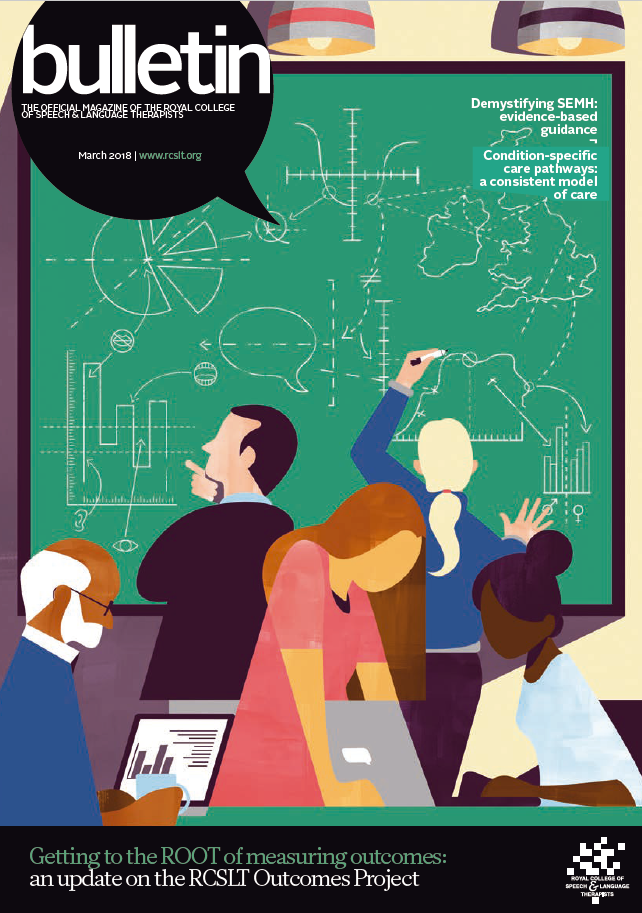| Authors | Helen Robinson |
|---|---|
| Journal | Bulletin. The official Magazine of the Royal College of Speech and Language Therapists, March 2020 |
| DOI | https://www.rcslt.org/ |
| File | Download Other Publication |
| External | Download Other Publication |

| Authors | Helen Robinson |
|---|---|
| Journal | Bulletin. The official Magazine of the Royal College of Speech and Language Therapists, March 2020 |
| DOI | https://www.rcslt.org/ |
| File | Download Other Publication |
| External | Download Other Publication |

In this article in Bulletin, Helen reflects on the impact of terminology when describing the tools in an AAC toolkit. Kindly reprinted/archived with permission of the RcSLT.
It’s long been accepted that the augmentative and alternative communication (AAC) journey starts with ‘low-tech’ systems, such as signing, Picture Exchange Communication System (PECS) books and symbol boards, and ultimately leads to a ‘high-tech’ voice output communication device, perhaps with ‘lite-tech’ AAC along the way. Many of us are taught, and accept, that the journey starts with one and leads to the other as a linear process, often with the individual abandoning their previous system as they go. However, we are now in an age where one ‘device’ might be used for all levels of communication, from single messages, to full symbolic or text-based language systems. With this in mind, how useful is it for us to still be using the terms low, lite and high-tech when referring to AAC systems? Recently I’ve begun to consider the connotations of these words and how they might reinforce the idea that AAC starts at A and ends at B, and, more importantly, that one might be better than the other.
The line between low-tech and lite-tech has always been blurry; often the terms are used interchangeably. However, over recent years, with the availability and popularity of relatively low-cost tablet computers, the line has become even less clear. What was once considered low/ lite-tech, might now fall into the realm of high-tech. Take the BIGmack switch, for example, often seen as a starting point for early communicators; this is now available as an app. So is this still low-tech, or is it now high-tech?
High-tech systems are often viewed as the best, the quickest and most desirable. Yet, increasingly I encounter clients for whom these systems aren’t the best. For many people, the strategies they’ve developed will ultimately serve them better; especially those who fi nd accessing such systems difficult and laborious. That’s not to say that these people will never use a communication aid; just that their symbol boards may often be a quicker, easier means of communicating. We might refer to AAC users as having a ‘toolkit’ of strategies for use at different times of day, in different situations and with different people. No tool is better than another, just different. Using the terms ‘low’ and ‘high’ to introduce the idea of AAC to individuals immediately gives the impression that the latter is superior: low is at the bottom; high is at the top. All too frequently we encounter parents, education professionals, support workers and spouses who are reluctant to invest their time and energy into using systems described as ‘low’ – and who can blame them? Perhaps if we were to use less loaded terminology to talk about AAC systems, they might be met with a better reaction? But what should we use instead?
The terms ‘aided’ and ‘unaided’ might serve us better, with ‘unaided’ referring to natural strategies, such as eye/finger pointing to objects, speech, vocalisations, facial expression, signing and gesture; and ‘aided’ referring to any form of communication system where the person is given symbols, photos or text to support their communication. Aided systems might be further broken down into ‘paper-based’, e.g. alphabet boards and symbol books; and ‘electronic’, e.g. tablets, single message switches and dedicated communication aids.
I think the terminology is likely to evolve over time, and no doubt others will have further suggestions for ways to describe AAC systems. In my clinical practice, I’m making a conscious eff ort to move away from the terms ‘low-tech’ and ‘high-tech’, but it is a challenge, as these terms are so familiar and accepted that I still find myself using them daily. But it’s a challenge worth pursuing as we endeavour to change the perceptions of those clients and families we work with when helping to identify the best AAC tools for that person.